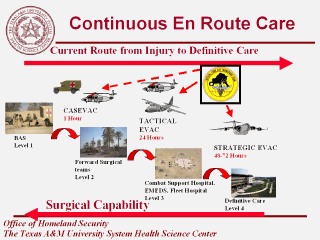 Click for
larger picture |
The answer to improving survivability was a
two-pronged approach. The first was to move life and limb saving surgical
intervention closer to the point of injury with the development of forward
surgical teams. With the speed of modern warfare and the absence of a true
front line, these light and lean surgical units can travel with the
warfighters and be set up and ready to operate in austere environments. For
this damage-control surgical intervention to be effective, the casualties
need to be moved out of the austere environment to definitive care quickly.
This required an en route critical care capability to transport these
stabilized patients from the tactical environment all the way back to
definitive care. The use of cargo aircraft of opportunity have enabled a
shortening of this timeline from two to three weeks to two to three days.
The introduction of critical care transport teams was vital to keeping this
new timeline for the severely injured and critically ill.
|
